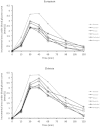The use of different reference foods in determining the glycemic index of starchy and non-starchy test foods
- PMID: 24885045
- PMCID: PMC4047427
- DOI: 10.1186/1475-2891-13-50
The use of different reference foods in determining the glycemic index of starchy and non-starchy test foods
Abstract
Background: Glycemic index (GI) is intended to be a property of food but some reports are suggestive that GI is influenced by participant characteristics when glucose is used as a reference.
Objective: To examine the influence of different reference foods on observed GI.
Design: The GIs of five varieties of rice and a sugary beverage (LoGiCane™) were tested in 31 European and 32 Chinese participants using glucose or jasmine rice as reference foods. The GIs of two ready-to-eat breakfast cereals (Kellogg's cornflakes and Sustain) were tested in 20 younger and 60 older people using glucose or Sustain as reference foods.
Results: The GIs of rice tended to be higher in the Chinese compared with the Europeans when glucose was used as a reference (jasmine 80 vs 68, P = 0.033; basmati 67 vs 57, P = 0.170; brown 78 vs 65, P = 0.054; Doongara 67 vs 55, P = 0.045; parboiled 72 vs 57, P = 0.011). There were no between-group differences in GI when jasmine rice was the reference. The GIs of breakfast cereals tended to be lower in younger compared with older groups (cornflakes 64 vs 81, P = 0.008; Sustain 56 vs 66, P = 0.054). There was no between-group difference in the GI of cornflakes when Sustain was the reference (cornflakes 115 vs 120, P = 0.64). There was no ethnic difference in GI when glucose was the reference for another sugary food (LoGiCane™ 60 vs 62; P = 0.69).
Conclusions: A starchy reference may be more appropriate than a glucose beverage when attempting to derive universally applicable GI values of starchy foods.
Trial registration: The Chinese/European trial is registered with the Australian New Zealand Clinical Trials Registry as ACTRN12612000519853.
Figures

Similar articles
-
Glycemic index, glycemic load and insulinemic index of Chinese starchy foods.World J Gastroenterol. 2010 Oct 21;16(39):4973-9. doi: 10.3748/wjg.v16.i39.4973. World J Gastroenterol. 2010. PMID: 20954285 Free PMC article. Clinical Trial.
-
Glycaemic responses to glucose and rice in people of Chinese and European ethnicity.Diabet Med. 2013 Mar;30(3):e101-7. doi: 10.1111/dme.12080. Diabet Med. 2013. PMID: 23181689
-
Glycaemic and insulin responses, glycaemic index and insulinaemic index values of rice between three Asian ethnic groups.Br J Nutr. 2015 Apr 28;113(8):1228-36. doi: 10.1017/S0007114515000586. Epub 2015 Mar 19. Br J Nutr. 2015. PMID: 25789978 Clinical Trial.
-
The glycemic index.World Rev Nutr Diet. 1990;62:120-85. World Rev Nutr Diet. 1990. PMID: 2180214 Review.
-
Low glycaemic-index foods.Br J Nutr. 2000 Mar;83 Suppl 1:S149-55. doi: 10.1017/s0007114500001094. Br J Nutr. 2000. PMID: 10889806 Review.
Cited by
-
Complete nutrition drink with retrograded starch is low glycemic, and the individual glucose response to the low glycemic complete nutrition drink depends on fasting insulin levels and HOMA-IR in a randomized cross-over control trial.J Nutr Sci. 2022 Apr 1;11:e25. doi: 10.1017/jns.2022.23. eCollection 2022. J Nutr Sci. 2022. PMID: 35462880 Free PMC article. Clinical Trial.
-
A Systematic Review of Literature on the Representation of Racial and Ethnic Minority Groups in Clinical Nutrition Interventions.Adv Nutr. 2022 Oct 2;13(5):1505-1528. doi: 10.1093/advances/nmac002. Adv Nutr. 2022. PMID: 35108358 Free PMC article.
-
Effect of ethnicity on glycaemic index: a systematic review and meta-analysis.Nutr Diabetes. 2015 Jul 13;5(7):e170. doi: 10.1038/nutd.2015.21. Nutr Diabetes. 2015. PMID: 26168085 Free PMC article.
-
Potential contributions of the methodology to the variability of glycaemic index of foods.World J Diabetes. 2021 Feb 15;12(2):108-123. doi: 10.4239/wjd.v12.i2.108. World J Diabetes. 2021. PMID: 33594331 Free PMC article. Review.
-
Raman Fingerprints of Rice Nutritional Quality: A Comparison between Japanese Koshihikari and Internationally Renowned Cultivars.Foods. 2021 Nov 29;10(12):2936. doi: 10.3390/foods10122936. Foods. 2021. PMID: 34945487 Free PMC article.
References
-
- Otto HBG, Pennartz M, Sabin G, Schauberger G, Spaethe K. Diatetik Bei Diabetes Mellitus. Bern: Verlag Hans Huber; 1973. Kohlenhydrataustausch nach biologischen aquivalenten. (Carbohydrate exchange according to biological equivalents) pp. 41–50.
-
- Crapo PA, Kolterman OG, Waldeck N, Reaven GM, Olefsky JM. Postprandial hormonal responses to different types of complex carbohydrate in individuals with impaired glucose tolerance. Am J Clin Nutr. 1980;33:1723–1728. - PubMed
-
- Jenkins DJ, Wolever TM, Taylor RH, Barker H, Fielden H, Baldwin JM, Bowling AC, Newman HC, Jenkins AL, Goff DV. Glycemic index of foods: a physiological basis for carbohydrate exchange. Am J Clin Nutr. 1981;34:362–366. - PubMed
-
- Wolever TM. The glycemic index. World Rev Nutr Diet. 1990;62:120–185. - PubMed
Publication types
MeSH terms
Substances
Associated data
LinkOut - more resources
Full Text Sources
Other Literature Sources
Medical

